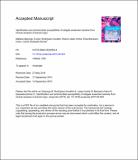| dc.contributor.author | BARQUERO-CALVO, ELIAS | |
| dc.contributor.author | Mayorga, Melissa | |
| dc.contributor.author | Rodríguez-Cavallini, Evelyn | |
| dc.contributor.author | López-Ureña, Diana | |
| dc.contributor.author | Quesada-Gómez, Carlos | |
| dc.date.accessioned | 2020-06-16T21:45:39Z | |
| dc.date.available | 2020-06-16T21:45:39Z | |
| dc.date.issued | 2015-09-14 | |
| dc.identifier.uri | http://hdl.handle.net/11056/17583 | |
| dc.description.abstract | The etiology of veterinary infectious diseases has been the focus of considerable research, yet relatively little is known about the causative agents of anaerobic infections. Susceptibility studies have documented the emergence of antimicrobial resistance and indicate distinct differences in resistance patterns related to veterinary hospitals, geographic regions, and antibiotic-prescribing regimens. The aim of the present study was to identify the obligate anaerobic bacteria from veterinary clinical samples and to determinate the in vitro susceptibility to eight antimicrobials and their resistance-associated genes. 81 clinical specimens obtained from food-producing animals, pets and wild animals were examined to determine the relative prevalence of obligate anaerobic bacteria, and the species represented. Bacteroides spp, Prevotella spp and Clostridium spp represented approximately 80% of all anaerobic isolates. Resistance to metronidazole, clindamycin, tetracycline and fluoroquinolones was found in strains isolated from food-producing animals. Ciprofloxacin, enrofloxacin and cephalotin showed the highest resistance in all isolates. In 17%, 4% and 14% of tetracycline-resistant isolates, the resistance genes tetL, tetM and tetW were respectively amplified by PCR whereas in 4% of clindamycin-resistant strains the ermG gene was detected. 26% of the isolates were positive for cepA, while only 6% harbored the cfxA (resistance-conferring genes to beta-lactams). In this study, the obligate anaerobic bacteria from Costa Rica showed a high degree of resistance to most antimicrobials tested. Nevertheless, in the majority of cases this resistance was not related to the resistance acquired genes usually described in anaerobes. It is important to address and regulate the use of antimicrobials in the agricultural industry and the empirical therapy in anaerobic bacterial infections in veterinary medicine, especially since antibiotics and resistant bacteria can persist in the environment | es_ES |
| dc.description.abstract | La etiología de las enfermedades infecciosas veterinarias ha sido objeto de considerables investigaciones, pero se sabe relativamente poco acerca de los agentes causales de las infecciones anaeróbicas. Los estudios de susceptibilidad han documentado la aparición de resistencia a los antimicrobianos e indican diferencias claras en las pautas de resistencia relacionadas con los hospitales veterinarios, las regiones geográficas y los regímenes de prescripción de antibióticos. El objetivo del presente estudio fue identificar las bacterias anaerobias obligatorias a partir de muestras clínicas veterinarias y determinar la susceptibilidad in vitro a ocho antimicrobianos y sus genes asociados a la resistencia. Se examinaron 81 especímenes clínicos obtenidos de animales productores de alimentos, mascotas y animales salvajes para determinar la prevalencia relativa de las bacterias anaerobias obligatorias, y las especies representadas. Bacteroides spp, Prevotella spp y Clostridium spp representaron aproximadamente el 80% de todos los aislamientos anaeróbicos. Se encontró resistencia al metronidazol, la clindamicina, la tetraciclina y las fluoroquinolonas en cepas aisladas de animales productores de alimentos. La ciprofloxacina, la enrofloxacina y la cefalotina mostraron la mayor resistencia en todos los aislamientos. En el 17%, el 4% y el 14% de los aislados resistentes a la tetraciclina, los genes de resistencia tetL, tetM y tetW fueron amplificados respectivamente por la PCR, mientras que en el 4% de las cepas resistentes a la clindamicina se detectó el gen ermG. El 26% de los aislados fueron positivos para la cepA, mientras que sólo el 6% albergaba el cfxA (genes que confieren resistencia a los betalactámicos). En este estudio, las bacterias anaeróbicas obligadas de Costa Rica mostraron un alto grado de resistencia a la mayoría de los antimicrobianos probados. No obstante, en la mayoría de los casos esta resistencia no estaba relacionada con los genes de resistencia adquiridos que se suelen describir en los anaerobios. Es importante abordar y regular el uso de antimicrobianos en la industria agrícola y la terapia empírica en las infecciones bacterianas anaerobias en la medicina veterinaria, especialmente porque los antibióticos y las bacterias resistentes pueden persistir en el medio ambiente. | es_ES |
| dc.description.sponsorship | Universidad Nacional, Costa Rica | es_ES |
| dc.language.iso | eng | es_ES |
| dc.publisher | Anaerobe | es_ES |
| dc.rights | Acceso abierto | es_ES |
| dc.rights.uri | http://creativecommons.org/licenses/by-nc-nd/4.0/ | |
| dc.source | Anaerobe Volume 36, December 2015, Pages 19-24 | es_ES |
| dc.subject | ANTIBIOTICOS | es_ES |
| dc.subject | MEDICINA VETERINARIA | es_ES |
| dc.subject | ENFERMEDADES INFECCIOSAS | es_ES |
| dc.subject | BACTERIAS | es_ES |
| dc.subject | ANTIMICROBIAL RESISTANCE | es_ES |
| dc.subject | RESISTANCE-ASSOCIATED GENES | es_ES |
| dc.subject | VETERINARY ANAEROBES | es_ES |
| dc.title | Identification and antimicrobial susceptibility of obligate anaerobic bacteria from clinical samples of animal origin | es_ES |
| dc.type | http://purl.org/coar/resource_type/c_6501 | es_ES |
| dc.description.procedence | Escuela de Medicina Veterinaria | es_ES |
| dc.identifier.doi | https://doi.org/10.1016/j.anaerobe.2015.09.003 | |


